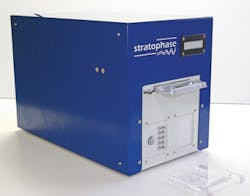BIOSENSORS/PORTABLE ANALYSIS INSTRUMENTATION: Optical microchip technology tested for veterinary, security applications
Stratophase (Romsey, England) has recently concluded two projects designed to assess the application of its optical microchip technology, which detects changes in the refractive index (RI) of a liquid passing over its surface. When used as a biodetector, the chip is coated with specific antibodies that bind with high specificity and affinity to biological targets. When a given toxin, bacteria or virus is present in the sample, it binds and triggers a positive detection. The tests involved applications in toxin detection (homeland security) and livestock farming.
A £1 million project called Portable Direct Immunoassay Diagnosis Devices for Animals and Humans (PDIDDAH), co-funded by the UK government-sponsored Technology Strategy Board (Swindon, England), assessed the feasibility of using a self-contained, portable instrument to accurately detect foot and mouth disease (FMD). Testing was performed in collaboration with the Institute of Biotechnology at the University of Cambridge (Cambridge, England), Bristol Industrial and Research Associates Ltd. (Bristol, England) and the Chelsea Technologies Group (Surrey, England).
During analysis, the sample is mixed with a liquid and pumped across the surface of the optical chip, where any FMD viral particles present bind to receptor molecules, altering the local RI and enabling detection. The chips themselves are incorporated into low-cost, disposable cartridges, which are inserted into the detection unit during testing. The chips can be configured to detect a whole range of biological agents, making them appropriate for on-site testing in environments as diverse as battlefields, hospitals and farms. If further developed, the device could facilitate informed decisions quickly, at the site of infection during disease outbreaks—and thus avoid the culling of healthy livestock. To that end, the company expects to commercialize the product for veterinary diagnostics through collaboration with partners in the field.
Another effort, the Portable Integrated Battlespace Biological Detection Technology (PIBBDT) project, involved a consortium of commercial, academic and military specialists in collector technology, biodetection and microfluidics. Led by manufacturer Biral and funded by the UK Ministry of Defense, this work involved building two fully functioning portable prototype systems for detecting biohazards in an atmosphere, which were tested in an exposure chamber using model-agents. The work demonstrated the feasibility of using the complete system to collect biological factors from the atmosphere, concentrate them in a liquid sample, and then detect pre-defined hazardous materials. The microchip was also tested separately in laboratories at the UK Defense Science and Technology Laboratory’s (DSTL’s) bioagent exposure facility with real targets, including several well-known bio-warfare factors, such as B. anthracis (the causative agent of anthrax) and Ricin toxin.
More BioOptics World Current Issue Articles
More BioOptics World Archives Issue Articles

